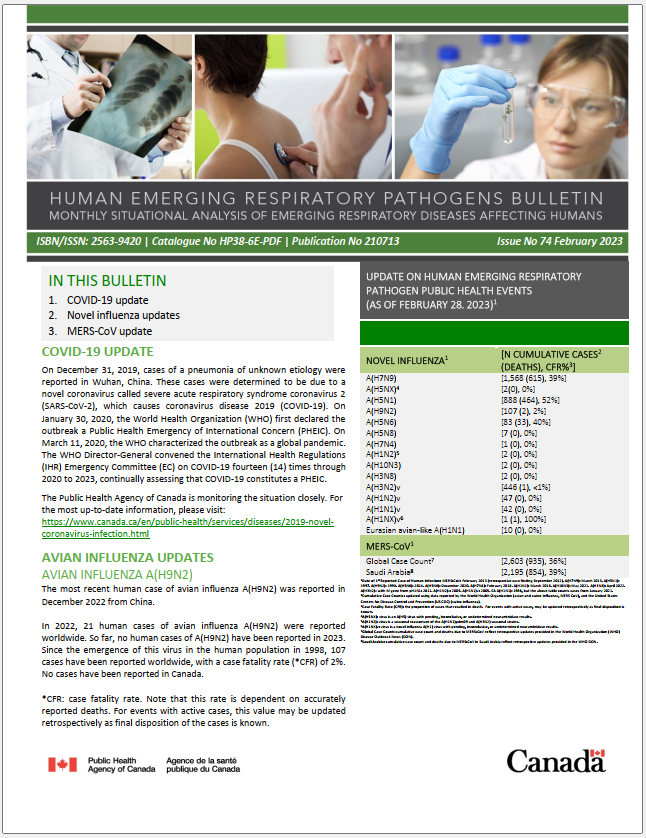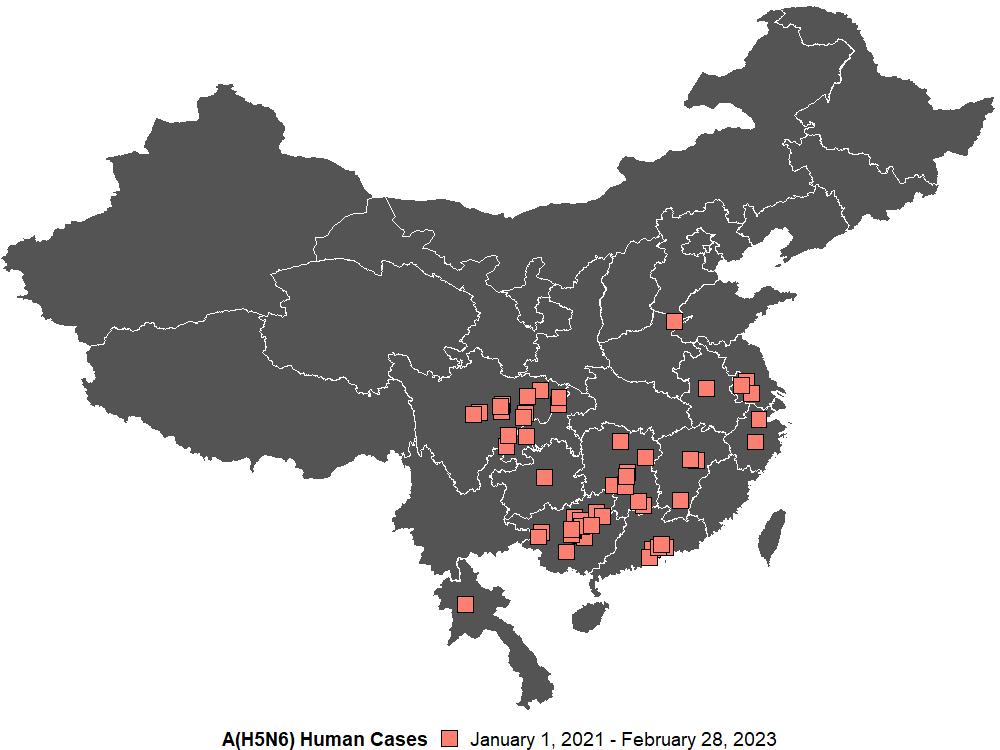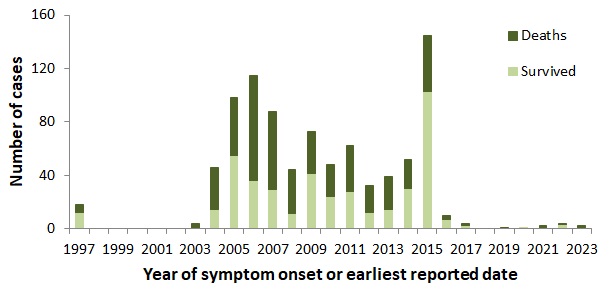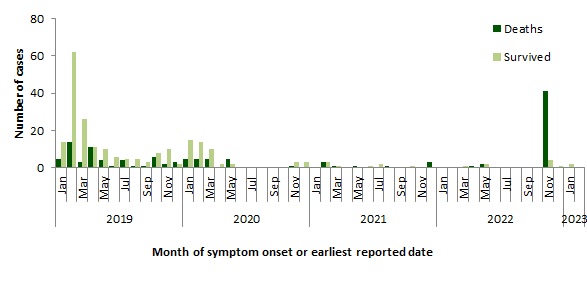Human emerging respiratory pathogens bulletin: Issue 74, February 2023

Download the alternative format
(PDF format, 1,324 KB, 3 pages)
Organization: Public Health Agency of Canada
Published: 2023-03-14
Monthly situational analysis of emerging respiratory diseases affecting humans (data to February 28, 2023).
In this bulletin
- COVID-2019 update
- Avian influenza updates
- Swine influenza updates
- Middle East respiratory syndrome coronavirus (MERS-CoV) update
| Novel influenzaFootnote 1 | Cumulative Case CountFootnote 2 | Deaths | Case Fatality Rate %Footnote 3 |
|---|---|---|---|
| A(H7N9) | 1,568 | 615 | 39% |
| A(H5N1) | 888 | 464 | 52% |
| A(H5NX)Footnote 4 | 2 | 0 | 0% |
| A(H9N2) | 107 | 2 | 2% |
| A(H5N6) | 83 | 33 | 40% |
| A(H5N8) | 7 | 0 | 0% |
| A(H7N4) | 1 | 0 | 0% |
| A(H1N2)Footnote 5 | 2 | 0 | 0% |
| A(H10N3) | 2 | 0 | 0% |
| A(H3N8) | 2 | 0 | 0% |
| A(H3N2)v | 446 | 1 | <1% |
| A(H1N2)v | 47 | 0 | 0% |
| A(H1N1)v | 42 | 0 | 0% |
| A(H1NX)vFootnote 6 | 1 | 1 | 100% |
| Eurasian avian-like A(H1N1) | 10 | 0 | 0% |
| MERS-CoVFootnote 1 | Cumulative Case CountFootnote 2 | Deaths | Case Fatality Rate %Footnote 3 |
| Global Case CountFootnote 7 | 2,603 | 935 | 36% |
| Saudi ArabiaFootnote 8 | 2,195 | 854 | 39% |
Footnotes
|
|||
COVID-2019 update
On December 31, 2019, cases of a pneumonia of unknown etiology were reported in Wuhan, China. These cases were determined to be due to a novel coronavirus called severe acute respiratory syndrome coronavirus 2 (SARS-CoV-2), which causes coronavirus disease 2019 (COVID-19). On January 30, 2020, the World Health Organization (WHO) first declared the outbreak a Public Health Emergency of International Concern (PHEIC). On March 11, 2020, the WHO characterized the outbreak as a global pandemic. The WHO Director-General convened the International Health Regulations (IHR) Emergency Committee (EC) on COVID-19 fourteen (14) times through 2020 to 2023, continually assessing that COVID-19 constitutes a PHEIC.
The Public Health Agency of Canada is monitoring the situation closely.
Avian influenza updates
Avian influenza A(H9N2)
The most recent human case of avian influenza A(H9N2) was reported in December 2022 from China.
In 2022, 21 human cases of avian influenza A(H9N2) were reported worldwide. So far, no human cases of A(H9N2) have been reported in 2023. Since the emergence of this virus in the human population in 1998, 107 cases have been reported worldwide, with a case fatality rate (*CFR) of 2%. No cases have been reported in Canada.
*CFR: case fatality rate. Note that this rate is dependent on accurately reported deaths. For events with active cases, this value may be updated retrospectively as final disposition of the cases is known.
Avian influenza A(H5N6)
The most recent human case of avian influenza A(H5N6) was reported in December 2022 from China.
A total of 83 laboratory-confirmed human cases of avian influenza A(H5N6), including at least 33 deaths (CFR: 40%) have been reported globally since 2014. Since January 2021, 57 cases of avian influenza A(H5N6) have been reported globally (Figure 2); 56 A(H5N6) cases were reported from China and one (1) case was reported from Lao PDR (Figure 3). In 2022, 25 A(H5N6) human cases were reported worldwide. So far, no human cases of A(H5N6) have been reported in 2023. No cases have been reported in Canadian residents.
Avian influenza A(H5NX)/A(H5N1)
Two (2) new human cases of avian influenza A(H5N1) were detected in February 2023 in Prey Veng province, Cambodia.
The first case was detected on February 22, 2023, in an 11-year-old female with an illness onset date of February 16, 2023, with fever, sore throat, and cough. The case received treatment at the local level and subsequently was sent to the National Children's Hospital in Phnom Penh with severe pneumonia for further treatment. The case died on February 22, 2023. The genetic sequence data of the virus from both cases were uploaded to the Global Initiative on Sharing All Influenza Data (GISAID) database, showing they both belong to clade 2.3.2.1c, which has been circulating in poultry in southeast Asia since 2014. The 2.3.2.1c viruses in Cambodia are different from H5N1 viruses currently circulating in wild birds and poultry in Canada and other countries, which are H5 clade 2.3.4.4b.
The second case was detected on February 24, 2023 and is the father of the first case. He is a 49-year-old male who reported fever and cough, and stayed in isolation at the referral hospital. He tested negative on February 27, 2023 and was released from the hospital on February 28, 2023.
An outbreak investigation determined the exposure of these two reported cases to the virus were from infected birds from the village. There was no human-to-human transmission between the father and daughter. The cases had animals (22 chickens, 3 ducks) at their home that recently died. There have also been an unusual number of deaths among wild birds in that area. The investigation team collected a total of 29 samples [16 close contacts, including the first case's father, and 13 with influenza-like-illness (ILI)]. Other than the sample from the father, all of the samples tested negative.
Since the emergence of A(H5N1) in humans in 1997, 888 human cases of A(H5N1) have been reported globally, with a CFR of 52%. No domestically acquired A(H5N1) infections have ever been reported in Canada. In 2014, Canada (Alberta) reported one single fatal case of A(H5N1) in a resident returning from travel in China.
According to a risk assessment published by the World Health Organization (WHO) in a Disease Outbreak News (DON) post on February 26, 2023, based on evidence so far, the virus does not infect humans easily and spread from person-to-person appears to be unusual. Since the virus continues to be detected in poultry populations, further human cases can be expected.Swine influenza updates
Swine origin influenza A(H1N2)v
The most recent human case of swine origin influenza was reported in December 2022 from Taiwan.
A total of 47 A(H1N2)v cases have been reported globally since 2005, with a 0% CFR. Eight (8) A(H1N2)v cases were reported worldwide in 2022. So far, no human cases of A(H1N2)v have been reported in 2023. Three (3) A(H1N2)v detections have been reported in Canadian residents since reporting began in 2005, and the latest case in Canada was reported in November 2021 from Manitoba.
Swine origin influenza A(H3N2)v
The most recent human case of swine origin influenza A(H3N2)v was reported in November 2022 from the United States.
Globally, 446 A(H3N2)v cases have been reported since 2005, with <1% case fatality rate. Five (5) A(H3N2)v cases were reported worldwide in 2022. Two (2) A(H3N2)v detections have been reported in Canadian residents since reporting began in 2005, with the latest case reported in June 2021.
Swine origin influenza A(H1N1)v
The most recent human case of swine origin influenza A(H1N1)v was reported in January 2023 from Spain.
Globally, 42 human cases of A(H1N1)v have been reported since 2005, with no associated fatalities. In 2022, four (4) A(H1N1)v cases were reported worldwide. So far, one (1) A(H1N1)v case has been reported worldwide in 2023. Two (2) A(H1N1)v detections have been reported in Canadian residents since reporting began in 2005, with the latest case reported in April 2021.

Figure 1 - Text description
Two (2) A(H5N1) cases were reported in Cambodia.
Note: Map was prepared by the Centre for Immunization and Respiratory Infectious Diseases (CIRID) using data from the latest WHO Event Information Site (EIS) postings. This map reflects data available through these publications as of February 28, 2023.

Figure 2 - Text description
| Year | Month | Cases |
|---|---|---|
| 2021 | Jan | 1 |
| Feb | 2 | |
| Mar | 2 | |
| Apr | 0 | |
| May | 0 | |
| June | 1 | |
| July | 4 | |
| Aug | 6 | |
| Sep | 6 | |
| Oct | 4 | |
| Nov | 0 | |
| Dec | 6 | |
| 2022 | Jan | 8 |
| Feb | 6 | |
| Mar | 3 | |
| Apr | 3 | |
| May | 1 | |
| June | 1 | |
| July | 0 | |
| August | 0 | |
| Sep | 1 | |
| Oct | 1 | |
| Nov | 0 | |
| Dec | 1 | |
| 2023 | Jan | 0 |
| Feb | 0 |
Note: Graph was prepared by the Centre for Immunization and Respiratory Infectious Diseases (CIRID) using data from the WHO EIS postings and the Hong Kong Centre for Health Protection (CHP) press releases. This graph reflects data available as of February 28, 2023.

Figure 3 - Text description
"Four cases were reported out of Yongzhou, Hunan Province, People's Republic of China.
Three cases were reported out of Guilin, Guangxi Zhuang Autonomous Region, People's Republic of China.
Three cases were reported out of Huizhou, Guangdong Province, People's Republic of China.
Three cases were reported out of Liuzhou, Guangxi Zhuang Autonomous Region, People's Republic of China.
Two cases were reported out of Baise, Guangxi Zhuang Autonomous Region, People's Republic of China.
Two cases were reported out of Chengdu, Sichuan Province, People's Republic of China.
Two cases were reported out of Chenzhou, Hunan Province, People's Republic of China.
Two cases were reported out of Dongguan, Guangdong Province, People's Republic of China.
Two cases were reported out of Guangxi Zhuang Autonomous Region, People's Republic of China.
Two cases were reported out of Hechi, Guangxi Zhuang Autonomous Region, People's Republic of China.
Two cases were reported out of Hengyang, Hunan Province, People's Republic of China.
Two cases were reported out of Sichuan Province, People's Republic of China.
Two cases were reported out of Tongnan District, Chongqing Municipality, People's Republic of China.
Two cases were reported out of Zhenjiang, Jiangsu Province, People's Republic of China.
One case was reported out of Anhui Province, People's Republic of China.
One case was reported out of Bazhong, Sichuan Province, People's Republic of China.
One case was reported out of Changde, Hunan Province, People's Republic of China.
One case was reported out of Deyang City, Sichuan Province, People's Republic of China.
One case was reported out of Fuzhou, Fujian Province, People's Republic of China.
One case was reported out of Ganzhou City, Jiangxi Province, People's Republic of China.
One case was reported out of Guizhou Province, People's Republic of China.
One case was reported out of Hangzhou, Zhejiang Province, People's Republic of China.
One case was reported out of Jiangxi Province, People's Republic of China.
One case was reported out of Kaijiang County, Sichuan Province, People's Republic of China.
One case was reported out of Laibin, Guangxi Zhuang Autonomous Region, People's Republic of China.
One case was reported out of Langzhong City, Sichuan Province, People's Republic of China.
One case was reported out of Luang Prabang Province, Lao People's Democratic Republic (the).
One case was reported out of Nanning, Guangxi Zhuang Autonomous Region, People's Republic of China.
One case was reported out of Puyang City, Henan Province, People's Republic of China.
One case was reported out of Xuanhan County, Sichuan Province, People's Republic of China.
One case was reported out of Yangzhou, Jiangsu Province, People's Republic of China.
One case was reported out of Yibin, Sichuan Province, People's Republic of China.
One case was reported out of Yongchuan District, Chongqing Municipality, People's Republic of China.
One case was reported out of Zhejiang Province, People's Republic of China.
One case was reported out of Zigong City, Sichuan Province, People's Republic of China.
One case was reported out of Nanning, Guangxi Province, People's Republic of China.
One case was reported out of Guangxi Zhuang Autonomous Region, People's Republic of China.
One case was reported out of Changsa, Hunan Province, People's Republic of China."
Note: Map was prepared by the Centre for Immunization and Respiratory Infectious Diseases (CIRID) using data from the WHO EIS postings and the Hong Kong Centre for Health Protection (CHP) press releases. This map reflects data available through these publications as of February 28, 2023.

Figure 4 - Text description
| Year | Number of Cases | Deaths | Survived |
|---|---|---|---|
| 1997 | 18 | 6 | 12 |
| 1998 | 0 | 0 | 0 |
| 1999 | 0 | 0 | 0 |
| 2000 | 0 | 0 | 0 |
| 2001 | 0 | 0 | 0 |
| 2002 | 0 | 0 | 0 |
| 2003 | 4 | 4 | 0 |
| 2004 | 46 | 32 | 14 |
| 2005 | 98 | 43 | 55 |
| 2006 | 115 | 79 | 36 |
| 2007 | 88 | 59 | 29 |
| 2008 | 44 | 33 | 11 |
| 2009 | 73 | 32 | 41 |
| 2010 | 48 | 24 | 24 |
| 2011 | 62 | 34 | 28 |
| 2012 | 32 | 20 | 12 |
| 2013 | 39 | 25 | 14 |
| 2014 | 52 | 22 | 30 |
| 2015 | 145 | 42 | 103 |
| 2016 | 10 | 3 | 7 |
| 2017 | 4 | 2 | 2 |
| 2018 | 0 | 0 | 0 |
| 2019 | 1 | 1 | 0 |
| 2020 | 1 | 0 | 1 |
| 2021 | 2 | 1 | 1 |
| 2022 | 5 | 1 | 4 |
| 2023 | 2 | 1 | 1 |
Note: Graph was prepared by the Centre for Immunization and Respiratory Infectious Diseases (CIRID) using data from the WHO EIS postings, the US CDC's Health Alert Network (HAN), and WHO cumulative case counts. This graph reflects data available as of February 28, 2023.
Middle East respiratory syndrome coronavirus (MERS-CoV) update
The most recent human cases of MERS-CoV were reported in January 2023 from Saudi Arabia (1) and Oman (1).
According to the WHO, 2,603 laboratory-confirmed cases of MERS-CoV, including 935 deaths, have been reported globally since reporting began in 2012 (CFR: 36%). So far, two (2) MERS-CoV cases have been reported globally in 2023. Seven (7) MERS-CoV cases were reported worldwide to the WHO in 2022. No cases have ever been reported in Canada.

Figure 5 - Text description
| Year | Month | Deaths | Survived |
|---|---|---|---|
| 2019 | Jan | 5 | 14 |
| Feb | 14 | 62 | |
| Mar | 3 | 26 | |
| Apr | 11 | 11 | |
| May | 4 | 10 | |
| June | 1 | 6 | |
| July | 4 | 5 | |
| Aug | 1 | 5 | |
| Sep | 1 | 3 | |
| Oct | 6 | 8 | |
| Nov | 2 | 10 | |
| Dec | 3 | 2 | |
| 2020 | Jan | 5 | 15 |
| Feb | 5 | 14 | |
| Mar | 5 | 10 | |
| Apr | 0 | 2 | |
| May | 5 | 2 | |
| June | 0 | 0 | |
| July | 0 | 0 | |
| Aug | 0 | 0 | |
| Sep | 0 | 0 | |
| Oct | 0 | 0 | |
| Nov | 1 | 3 | |
| Dec | 0 | 3 | |
| 2021 | Jan | 0 | 0 |
| Feb | 3 | 3 | |
| Mar | 1 | 1 | |
| Apr | 0 | 0 | |
| May | 1 | 0 | |
| June | 0 | 1 | |
| July | 0 | 2 | |
| Aug | 1 | 0 | |
| Sep | 0 | 0 | |
| Oct | 0 | 1 | |
| Nov | 0 | 0 | |
| Dec | 3 | 0 | |
| 2022 | Jan | 0 | 0 |
| Feb | 0 | 0 | |
| Mar | 0 | 1 | |
| Apr | 1 | 0 | |
| May | 2 | 2 | |
| June | 0 | 0 | |
| July | 0 | 0 | |
| August | 0 | 0 | |
| Sep | 0 | 0 | |
| Oct | 0 | 0 | |
| Nov | 41 | 4 | |
| Dec | 0 | 1 | |
| 2023 | Jan | 0 | 2 |
| Feb | 0 | 0 |
Note: Graph was prepared by the Centre for Immunization and Respiratory Infectious Diseases (CIRID) using data from the WHO Disease Outbreak News (DON) and Saudi Arabia's Ministry of Health. This graph reflects data available as of February 28, 2023. The data integrates CIRID real-time reporting with WHO DON retrospective reporting of MERS-CoV cases and deaths. In November 2022, the WHO published a Disease Outbreak News (DON) article that updated their counts with retrospective cases and deaths, which resulted in an increase of an additional 5 cases and 41 deaths compared to their previous MERS-CoV-related DON.